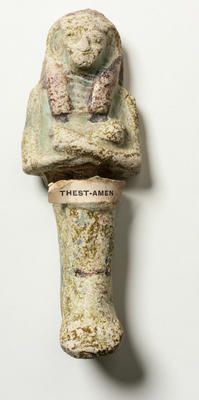Shabti, Thestamen
Production date
1550 BCE-1069 BCE
Country
Egypt
See full details
Object detail
Description
Egyptian, white-green, faience shabti. Shabti stands straight with feet together and arms folded, wearing a lappet-wig. Traces of black paint depicting the wig. Abraided surface. The name "Thest-amen" on small rectangular paper label affixed to the shabti. Originally stood on plinth, with remnant glue fixative on back. No heiroglyphs on reverse.
Classification
ARCHAEOLOGY Egyptian figure
Production date
1550 BCE-1069 BCE
Production place
Measurements
L130mm x W50mm x D30mm
Media/Materials description
Egyptian faience is a ceramic material with a siliceous body and brightly coloured glaze.
Faience (composed of quartz, alkaline salts [natron or plant ash], lime, and metallic mineral-based colorant)
Glaze (formed by alkali and lime reacting with silica to form the glaze)
Faience (composed of quartz, alkaline salts [natron or plant ash], lime, and metallic mineral-based colorant)
Glaze (formed by alkali and lime reacting with silica to form the glaze)
History and use
Shabtis (Egyptian ushabti), are funerary figurines, usually mummiform in appearance, which developed during the Middle Kingdom. They were buried with a person, standing in place of the deceased and their servants. They were intended to free the deceased from the necessity of labour in the afterlife, which was required for the deceased to produce their own food.
Associated person
Registration number
E40055



